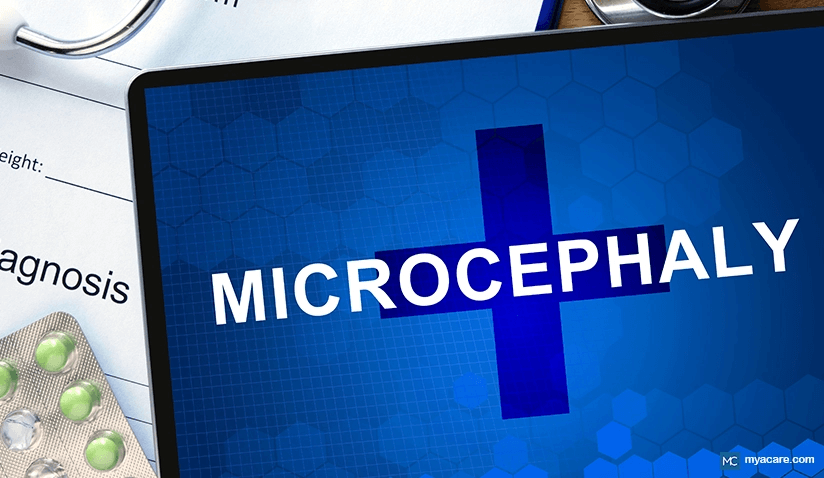What Is Microcephaly? – Causes, Impact on Development and the Importance of Early Detection

Medically Reviewed and Updated by Dr. Rae Osborn, Ph.D. - September 3, 2024
Microcephaly is a term that might not be familiar to everyone, but it holds great significance for those affected by it. It refers to a condition where an individual has a smaller-than-average head size, which can have profound implications on their development and overall life.
In this blog post, we will discuss microcephaly, exploring its causes, symptoms, and the various treatment options available to support those affected. Let us begin by understanding what microcephaly is and what it means for a child to have a small head size.
What is Microcephaly?
Microcephaly is a neurological condition that affects infants and children, characterized by an abnormally small head size for their age and gender that negatively impacts brain development. It is a rare condition and according to research, about 1 in every 1,150 babies is born with microcephaly in the United States.[1]
There are two main types of microcephaly: primary and secondary.
Primary or Congenital Microcephaly is acquired in utero, and secondary or postnatal microcephaly is acquired after birth. The brains of infants with congenital microcephaly are smaller than expected at birth, with a lower number of neurons and impaired neurogenesis.
Infants with Secondary Microcephaly have a normal brain size at birth, yet the brain fails to grow at the expected growth rate afterward, leading to a smaller brain size later on and difficulty regarding neuroplasticity (formation of synaptic connections).[2]
Causes of Microcephaly
Multiple causes can lead to microcephaly, all of which interfere with brain growth. Common mechanisms involve factors that cause brain cells to die off or genetic mutations that disrupt cell division. Understanding the causes is essential for early detection and prevention. Well-known microcephaly causes are described below.[3]
- Genetics. Microcephaly can be a standalone genetic disorder called autosomal recessive primary microcephaly. At least 7 genes have been implicated in causing this disorder, with one of the main mutations known to occur on the X chromosome from each parent. Other inherited conditions that disrupt normal brain growth can also cause microcephaly.
- Infections. Infections like Zika virus, Chickenpox, Toxoplasmosis, Rubella, and Cytomegalovirus contracted during pregnancy can increase the risk of microcephaly in the unborn child. Zika virus is currently the most common infection known to cause microcephaly. Pregnant mothers ought to be aware of the risks of contracting an infection while traveling abroad.
- Environmental Exposures. Exposure to radiation, harmful substances or toxic chemicals during pregnancy, such as heavy metals, smoking, and alcohol, can also contribute to microcephaly. These exposures are often coupled with fetal malnourishment that increase the risk of birth defects. Additionally, prescription medications, such as anti-seizure agents, isotretinoin and methotrexate, may promote microcephaly development in utero.[4]
- Traumatic Brain Injury. Children who experience traumatic brain injuries or brain oxygen deprivation after birth can develop secondary microcephaly. A stroke during pregnancy can deprive the fetus of sufficient oxygen that contributes to microcephaly.
Microcephaly Symptoms and Developmental Impact
Microcephaly can manifest with a range of symptoms, such as delayed development, intellectual disabilities, and physical challenges. Having a smaller head size and impaired brain development can be detrimental to the child’s ability to grow and learn.
Aside from a smaller head size, early symptoms of microcephaly include[5]:
- A poor appetite
- A characteristic high-pitched cry
- Involuntary muscle contractions or spasms
- Reduced sense of balance and coordination for age
- Hearing loss
- Poor vision
- Seizures
As the child matures, facial deformities, speech deficits, and severe learning disabilities may become more evident. Despite growing, the child’s head size usually remains proportionately smaller throughout their lifespan. Other children grow normally, even with microcephaly at birth.
Understanding these symptoms is essential in providing appropriate care and support for affected children.
Treatments for Microcephaly
There is no cure or treatment for microcephaly. Instead, treatment focuses on early detection, successful prevention, and interventions that can help children with the condition achieve their full potential and lead fulfilling lives. Occupational, speech, and physical therapy may be helpful for some patients. Patients may also need medicine if they suffer from seizures.
Check-ups with a pediatric neurologist should be routinely performed for children with microcephaly to keep track of their development and assist them as best as possible at every step of the way. This helps the parents and doctors to know of any other developmental problems that arise later on.
Detection and Diagnosis
Microcephaly is often detected after birth, with a head measurement taken on day 1. Additional tests may be required to clarify genetic disorders and physical abnormalities, often achieved through the use of blood tests, CT scans, or MRIs.[6]
Early detection may be possible with an ultrasound scan at the end of the second trimester or in the third trimester. While it is often too late to avoid, a pregnant mother can still try to minimize developmental damage by reducing any potential factors that may have contributed.
It can be a good idea to consult with a nutritionist about nutrients that may help enhance fetal growth and protect against further deformity. A pregnant mother may also wish to consult with a skilled physician to make sure she is not fighting an active infection that may harm the fetus or increase the risk of miscarriage.
The Vital Role of Early Intervention
Early intervention for microcephaly is crucial in helping affected children reach their full potential. These services include therapies, instruction, and other forms of assistance that aid in children's social, motor, and cognitive development. Intervention ought to be started as early as possible for the best results.
Examples of early intervention services include:
- Speech therapy, which can help children with microcephaly improve their communication skills.
- Occupational therapy that can help them develop fine motor skills.
- Physical therapy can help improve gross motor skills and coordination in children with microcephaly.
As a parent, you will need to put together a team of healthcare professionals who can assist and guide you on the best options. The services you opt for need to address the child’s unique needs so that their full potential can be met in life.[7] Checkups with a neurologist may be required if the child misses a milestone in order to know how to proceed.
Support for Families Living with Microcephaly
It can be a challenge to raise a child with microcephaly, and family support should not be underestimated. Parents are advised to find a community or support group online that can help them face all the difficulties they may experience along the way. Others struggling with the same challenges may be able to provide extra resources for families of children with microcephaly, including contacts for excellent therapists and disability programs.
Treatments Addressing Microcephaly Complications
While the condition itself is not treatable, some children with microcephaly exhibit complications that can be remedied with medication and surgery, as described below:
- Medication. In some cases, medication may be prescribed to manage specific symptoms or associated conditions, such as seizures. There has been research into gene therapy as a way to treat microcephaly.[8] This may lead to the development of new treatment options for patients in the future.
- Surgery. Surgical procedures may be considered in situations where there is a physical issue that can be corrected or improved to enhance the child's quality of life. Examples include Trigonocephaly and Craniosynostosis, in which microcephaly is caused by deformed bone growth that can give rise to an abnormally shaped skull.
Prognosis for Children with Microcephaly
The prognosis for microcephaly varies widely depending on several factors, including the underlying cause, the severity of the condition, and the availability of early intervention services.
Most children born with the condition who have the severe form of the condition have a reduced life expectancy. Those with milder forms of microcephaly may experience fewer challenges and have a better prognosis than those with more severe cases. Prognosis and severity tend to be worse in children with intrauterine infections or chromosomal disorders. [9] Children with secondary microcephaly may have a better prognosis if intervention begins early on.
Early intervention services have been proven to help newborns, infants, and children with microcephaly drastically improve their physical and mental skills. Community support is essential for optimal success.
Conclusion
Microcephaly is a condition that affects not just the size of a child's head but their entire life. Understanding its causes, symptoms, and available treatments is vital for both medical professionals and the broader community. With early intervention and unwavering support, children with microcephaly can reach their full potential and lead fulfilling lives.
To search for the best Neurology Doctors and Healthcare Providers worldwide, please use the Mya Care search engine.
To search for the best doctors and healthcare providers worldwide, please use the Mya Care search engine.
The Mya Care Editorial Team comprises medical doctors and qualified professionals with a background in healthcare, dedicated to delivering trustworthy, evidence-based health content.
Our team draws on authoritative sources, including systematic reviews published in top-tier medical journals, the latest academic and professional books by renowned experts, and official guidelines from authoritative global health organizations. This rigorous process ensures every article reflects current medical standards and is regularly updated to include the latest healthcare insights.

Dr. Rae Osborn has a Ph.D. in Biology from the University of Texas at Arlington. She was a tenured Associate Professor of Biology at Northwestern State University, where she taught many courses to Pre-nursing and Pre-medical students. She has written extensively on medical conditions and healthy lifestyle topics, including nutrition. She is from South Africa but lived and taught in the United States for 18 years.
Sources:
Featured Blogs



